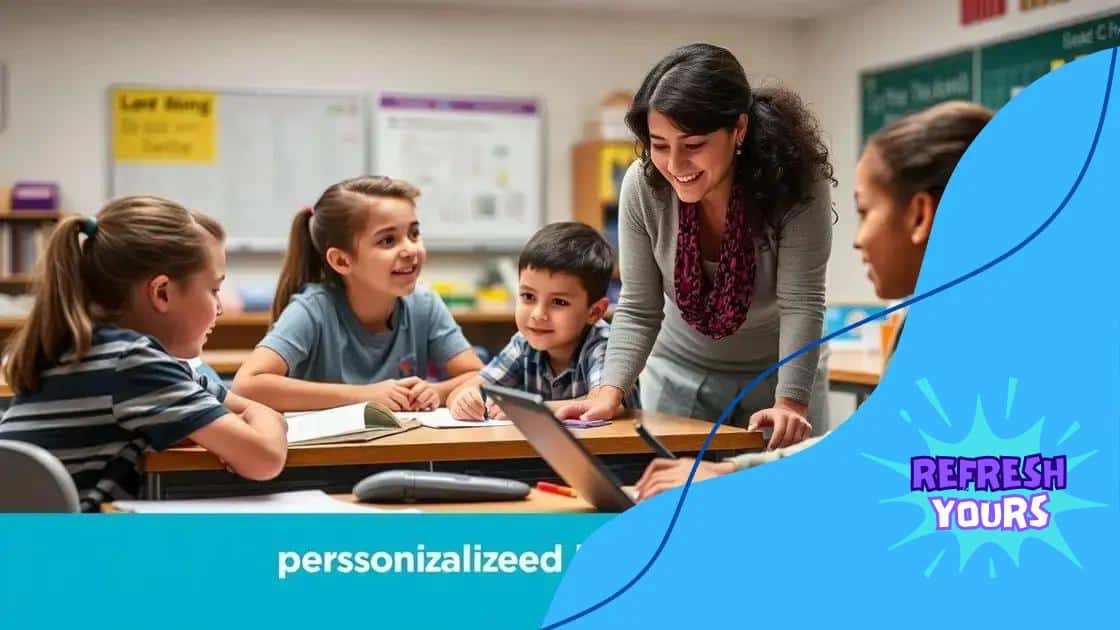How AI is helping teachers identify struggling students

AI helps teachers identify struggling students by analyzing performance data to detect learning difficulties early, enabling personalized interventions that enhance educational outcomes.
How AI is helping teachers identify struggling students offers a glimpse into a transformative approach to education. Imagine spotting challenges before they escalate, thanks to advanced technology. Curious about how it works? Let’s explore.
Understanding the role of AI in education
Understanding the role of AI in education is crucial for both teachers and students. With advancements in technology, teachers now have tools that help them track student progress and behavior more efficiently.
How AI Supports Teachers
AI can provide valuable insights into a student’s learning patterns. For instance, it can analyze performance data and highlight areas where students struggle. This early detection is key to offering timely support.
- Identifies students who may need extra help.
- Provides tailored learning recommendations.
- Offers resources for improving specific skills.
As teachers use these tools, they can create individualized learning experiences. This approach not only supports those who are struggling but also enriches the learning environment for all students.
Benefits of AI in the Classroom
AI offers several benefits that are transforming the classroom experience:
- Streamlined administrative tasks, allowing teachers to focus more on teaching.
- Access to personalized learning resources based on student data.
- Greater engagement through interactive learning methods.
- Robust feedback mechanisms for continuous improvement.
Furthermore, teachers can use AI to facilitate better communication with students and parents. By sharing insights and progress reports, they foster a partnership that enhances educational outcomes.
The integration of AI in education is not just a trend; it is a pivotal shift in how learning occurs. As technology continuously evolves, so does the potential for improving educational practices.
Early detection of learning difficulties with AI
Early detection of learning difficulties with AI can make a significant difference in a student’s educational journey. By using advanced analytics, teachers can spot warning signs before challenges become too overwhelming.
How AI Identifies Learning Challenges
AI systems analyze data from various sources, including test scores, assignments, and attendance records. They identify patterns that may indicate learning issues. This proactive approach allows educators to intervene early.
- Students showing a drop in performance over time.
- Patterns of repeated mistakes in specific subjects.
- Consistent struggles with homework completion.
With these insights, teachers can tailor their strategies for individual students. Instead of waiting for formal assessments, they can provide assistance as soon as concerns arise.
The Importance of Timely Intervention
Intervening early is crucial in supporting students who need it most. Research shows that the sooner students receive help, the better their chances of success.
- Boosts student confidence and motivation.
- Reduces the likelihood of long-term academic struggles.
- Encourages a positive learning environment for everyone.
As teachers harness AI to pinpoint issues quickly, they can also streamline their interventions. This lets them focus on creating effective and personalized solutions for each learner.
Utilizing technology in this way not only enhances educational outcomes but also fosters a supportive atmosphere where every student can thrive.
Personalized learning paths for students

Personalized learning paths for students are becoming increasingly important in today’s education landscape. With the help of AI, educators can create customized plans that cater to each student’s unique needs and learning styles.
The Role of AI in Personalization
AI technology collects and analyzes data from various activities and assessments. This data can include anything from test scores to classroom participation. Using these insights, teachers can design specific learning paths for each student that focus on their strengths and address their weaknesses.
- Allows adaptation of content based on individual performance.
- Enables real-time feedback to students.
- Encourages self-paced learning, leading to better engagement.
By keeping the students’ interests in mind, teachers can tailor experiences that spark curiosity and encourage deeper understanding.
Benefits of Personalized Learning Paths
Personalized learning offers various benefits for both students and teachers. For one, students feel more engaged when the material resonates with them personally. This engagement can lead to improved performance and motivation.
- Reduces frustration by addressing specific challenges.
- Enhances mastery of subjects and skills.
- Increases student autonomy and responsibility for learning.
As students progress along their personalized paths, teachers can adjust the materials and methods based on ongoing assessments. This dynamic approach not only keeps students on track but also promotes a growth mindset, helping them realize that persistence is key to overcoming challenges.
Utilizing personalized learning paths is not just a trend; it represents a significant shift towards more effective and meaningful education. Embracing this method can undoubtedly transform the way students learn and succeed in the classroom.
Case studies of successful AI implementations
Case studies of successful AI implementations in education provide powerful examples of how technology can enhance learning experiences. Schools and educators across the globe are adopting AI tools to improve student outcomes and support teachers.
Example 1: Data-Driven Decision Making
One school district in California adopted an AI-powered analytics platform to monitor student performance. By analyzing data from quizzes, attendance, and engagement, the system identified at-risk students early. As a result, teachers could intervene before these students fell too far behind.
- Improved identification of students needing support.
- Data-driven insights led to targeted learning strategies.
- Increased overall student performance within the district.
This proactive approach not only helped struggling students but also allowed teachers to focus on effective teaching methods tailored to individual needs.
Example 2: Personalized Learning Environments
Another notable case comes from a school in New York that implemented a personalized learning program using AI. The platform adjusted lesson plans based on student progress and preferences. This approach allowed students to learn at their own pace and style.
- Students became more engaged in their learning.
- Teachers received real-time feedback on student progress.
- Academic performance improved across various subjects.
The shift towards personalized learning paths demonstrated that when students are empowered to take charge of their education, excitement and success follow.
Example 3: Enhanced Teacher Support
A university in Texas integrated AI to assist faculty in grading and developing curriculum resources. The system analyzes student submissions and provides suggestions for future learning activities based on data trends.
- Reduced grading workload for instructors.
- Enhanced curriculum adaptability based on student needs.
- Increased focus on direct student-teacher interactions.
As a result, faculty could dedicate more time to mentoring students and fostering a collaborative learning environment.
These case studies illustrate the tangible benefits of integrating AI into educational settings. With thoughtful application, AI not only supports students but also enhances the teaching profession.
Future implications of AI in the classroom
The future implications of AI in the classroom are vast and offer exciting possibilities for both educators and students. As technology continues to advance, it is reshaping how education is delivered and experienced.
Transforming Teaching Methods
One major change is the way teachers deliver lessons. AI can help create dynamic and interactive learning environments. For instance, with virtual assistants, students can ask questions outside classroom hours, promoting a continuous learning process. This integration encourages a more engaging and personalized educational experience.
- Enhanced lesson plans tailored to student needs.
- Immediate feedback on student performance.
- Resources adapting in real-time based on learning pace.
Moreover, educators can utilize AI to streamline administrative tasks. By automating grading and scheduling, teachers can devote more time to direct interaction with students.
Redefining Student Support
AI has the potential to revolutionize how support is provided to students. Predictive analytics can identify at-risk students early, allowing for timely interventions. This early detection aids in crafting personalized support strategies.
- Supports differentiated instruction tailored to unique learning styles.
- Increases accessibility for students with learning disabilities.
- Promotes social-emotional learning through targeted resources.
As AI tools become more sophisticated, they will offer even deeper insights into how students learn, paving the way for innovative teaching strategies and resources that were previously unimaginable.
Ethical and Inclusive Considerations
However, integrating AI also raises important ethical considerations. Ensuring equitable access to technology is crucial to avoid widening the achievement gap. Schools must address issues surrounding data privacy and the security of student information.
In the future, it will be essential for education systems to foster an environment where every student has the opportunity to thrive with AI. This means investing in training for teachers to use AI technologies effectively, making sure that all students benefit from these advancements.
As we look ahead, the collaboration between AI and education has the potential to transform classrooms into more adaptable, inclusive spaces. By harnessing this technology wisely, we can create a future where learning becomes a more personalized and enriching journey for every student.
As we look to the future, the integration of AI in education will reshape learning in many positive ways. With personalized learning paths, early detection of challenges, and supportive environments, students can receive the help they need. Teachers will also benefit from reduced workloads and enhanced teaching strategies. However, it’s essential to ensure that all students have access to this technology in a fair manner. By embracing AI wisely, we pave the way for a more innovative and inclusive educational experience for everyone. 🌟
FAQ – Frequently Asked Questions about AI in Education
How does AI help identify struggling students?
AI analyzes student data to detect patterns and early signs of learning difficulties, allowing teachers to intervene promptly.
What are personalized learning paths?
Personalized learning paths are customized educational experiences tailored to each student’s unique strengths, challenges, and pacing.
How can AI reduce teachers’ workloads?
AI automates administrative tasks like grading and data analysis, freeing up more time for teachers to focus on direct student support.
What ethical considerations come with using AI in education?
It’s important to ensure that all students have fair access to AI technology and that their data privacy is protected.





